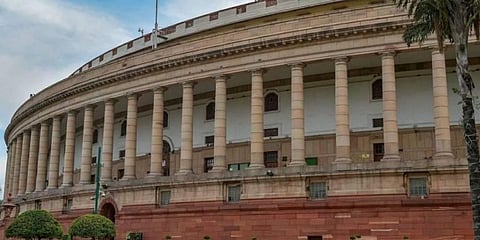

Every session of Parliament brings with it nuggets on the state of affairs, particularly in the states. The information, when perused and parsed, reveal answers which often trigger questions on the context the collective consciousness dwells in. Here are a few factoids on governance from Parliament.
Like COVID-19 is back in the discourse following the headlines from China. For sure allocation for health is up – from Rs 47,353 crore in 2017-18 to Rs 83,000 crore in 2022-23. Money though has not eradicated the shortage. Of the 74813 posts for doctors sanctioned for 11 major hospitals and institutes across the country managed by the Centre 30512 are vacant – mostly in the new AIIMS hospitals outside Delhi. India currently has 13, 08,009 allopathic doctors (and 5.6 lakh Ayush doctors) for a population of 1.4 billion and two nurses per 1000 persons.
Like the gaps in capacity is stark in rural India. Over 18900 posts of doctors are vacant in district hospitals and health centres – 362 in Odisha, 340 in Karnataka, and 271 in Chhattisgarh. Also vacant are posts of paramedics, pharmacists and technicians. The promise of converting primary centres into wellness centres is yet a work in progress.
Like the issue of unemployment is a constant in India’s political narrative. The paradoxical coexistence of vacant posts and clamour for jobs persists. Citing a report of the Pay Research Unit, the government revealed that 9.79 lakh posts are lying vacant in the departments and PSUs under the Central Government – defence, home, railways, posts and revenue ministries account for over 5 lakh of the
vacant posts.
Like the gap in capacity is showing up in the processes and outcomes of the government. In October 2022 the Prime Minister launched a 'rozgar mela' to recruit 10 lakh persons in 18 months. The target is daunted by systemic apathy – despite questions and circulars, in the past five years, the central government filled a total of 3.77 lakh posts.
Like it is known that during the pandemic millions of children could not go to school for two years. This week, the government informed parliament that between 2021-21 and 2021-22 over 20000 schools have closed down and that the number of teachers has declined by 1.89 lakh across India’s schools. This is
bound to have grave repercussions on an already broken education system -- for the students and for India in the long term.
Like the success of the skills development programme depends on successful placements. This week the Standing Committee of Parliament for the Ministry of Labour provided a vignette of the uphill task. As of June 30, 2022, of the 3.99 lakh certified candidates trained under the PM Kaushal Vikas Yojana only
30,599 got placed in jobs. In the previous version (PMKVY 2.0) barely a fourth or 21.32 lakh of 91.38 lakh certified candidates got placements.
Like the factor critical for skills training is the availability of faculty at Industrial Training Institutes. The Committee overseeing the outcomes in the Ministry of Labour discovered via the National Council for Vocational Training that as of May 2022 out of the 1.99 lakh sanctioned posts of professionals across ITIs in the country as many as 1.29 lakh posts were vacant.
Like success in cleaning up bad loans in banks via the Insolvency and Bankruptcy Code 2016 is haunted by pendency at the National Company Law Tribunal. Data revealed to Parliament shows 12,871 cases were pending at the NCLT as on October 31, 2022. The data on recovery is fuzzy and dated. As of December 2021, in 444 cases Rs 2.5 lakh crore out of Rs 7.54 lakh crore has been realised through the IBC process. On Monday the government revealed that in the past five years banks wrote off Rs. 10,09,511 crore.
Like there is no disputing need to empower panchayats. The Rashtriya Gram Swaraj Abhiyan is the flagship scheme. The Standing Committee on rural development discovered panchayats have been starved of funds critical for the construction of Panchayat Bhawans, computerization and technical manpower. In 2020-21 only Rs 499.9 crore of the Rs 3337.8 crore was released and in 2021-22 Rs 518 crore of Rs 4480 crore approved was released. The reason: non-compliance of norms by state governments.
Like the death of Cyrus Mistry, earlier this year highlighted the many vulnerabilities of travelling on India’s highways. This week the government was asked for data on the number of accidents caused by road engineering defects. The response: The Transport Research Wing of the Ministry of Road Transport ‘does not compile road accidents data on the basis of road engineering defects.’ Why wouldn’t black spots be recorded and made public for motorists? Mind you this is a country where over 1.5 lakh persons die in road accidents every year.
Like, the policy of disallowing vehicles older than 15 years to ply on India’s roads is a political hot potato given the implication on the cost of new vehicles. In November 2022 the government issued a notification prohibiting the renewal of registration of all government vehicles older than 15 years. The number of vehicles likely to be scrapped: approximately 1.28 lakh. It begs the question: how many vehicles do governments own? Meanwhile, the decision to scrap vehicles has been left to the departments!
Finally here is wishing the very best for the New Year. We live in interesting times.
Shankkar Aiyar
Author of The Gated Republic, Aadhaar:
A Biometric History of India’s 12 Digit
Revolution, and Accidental India
shankkar.aiyar@gmail.com